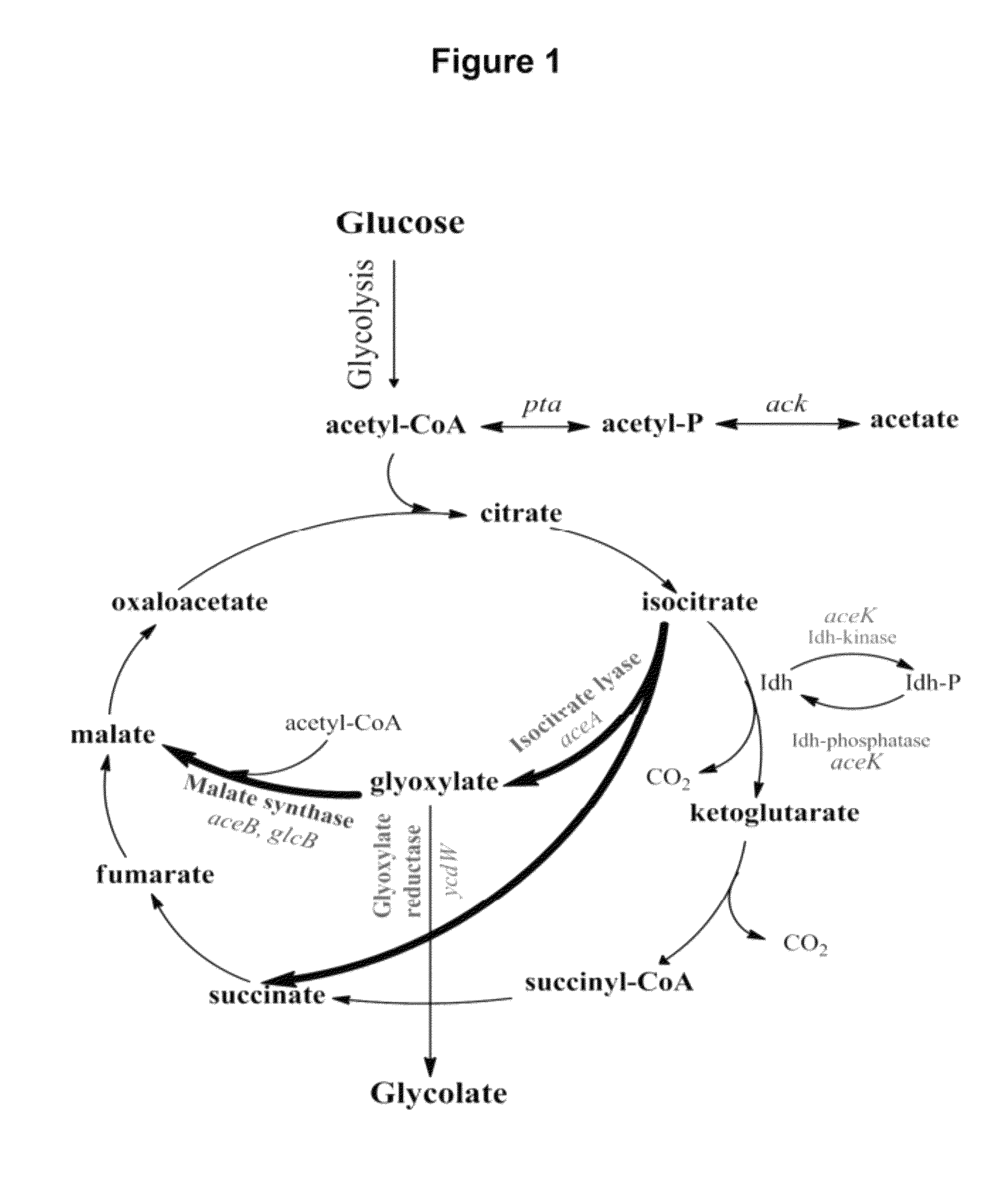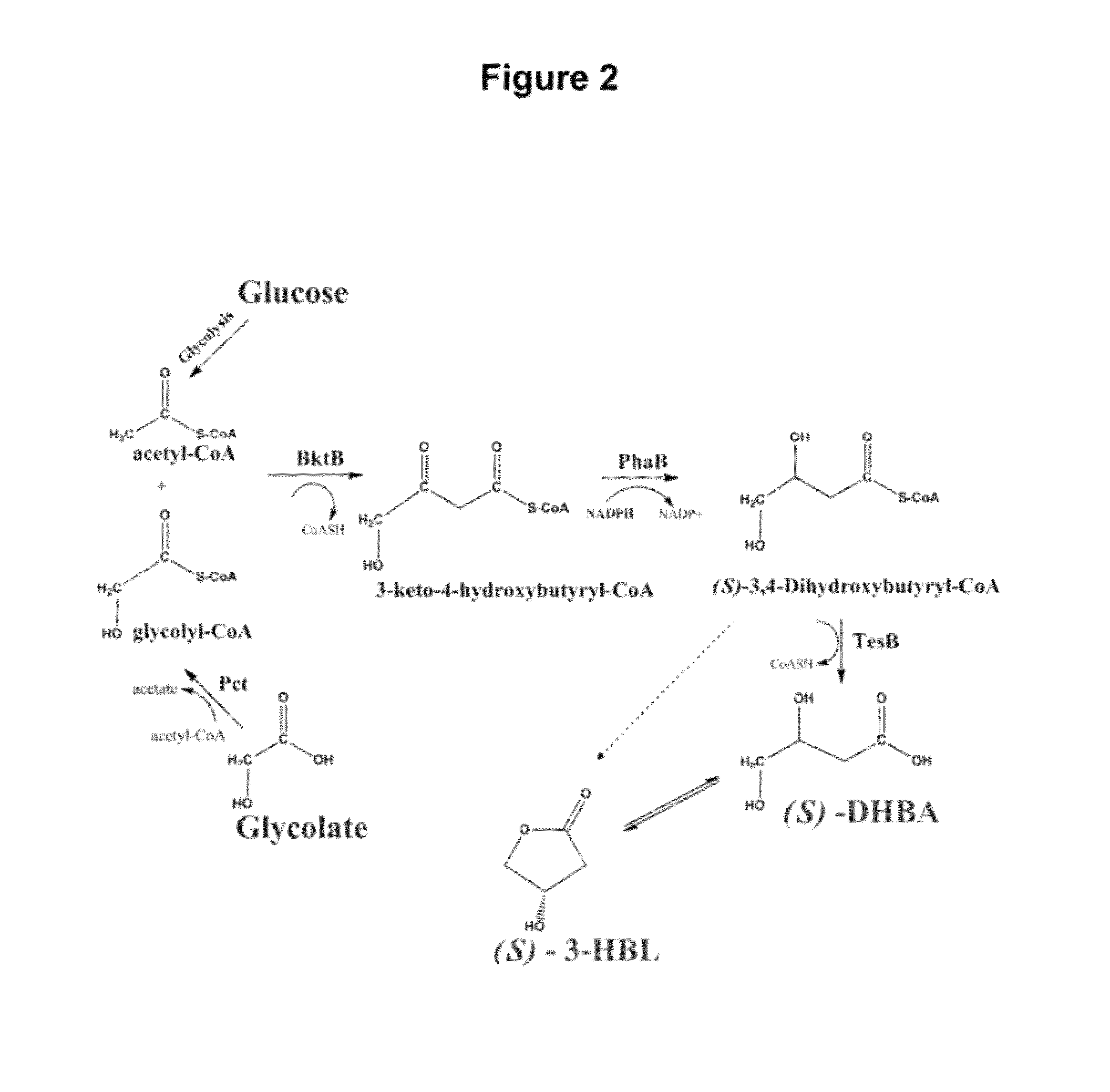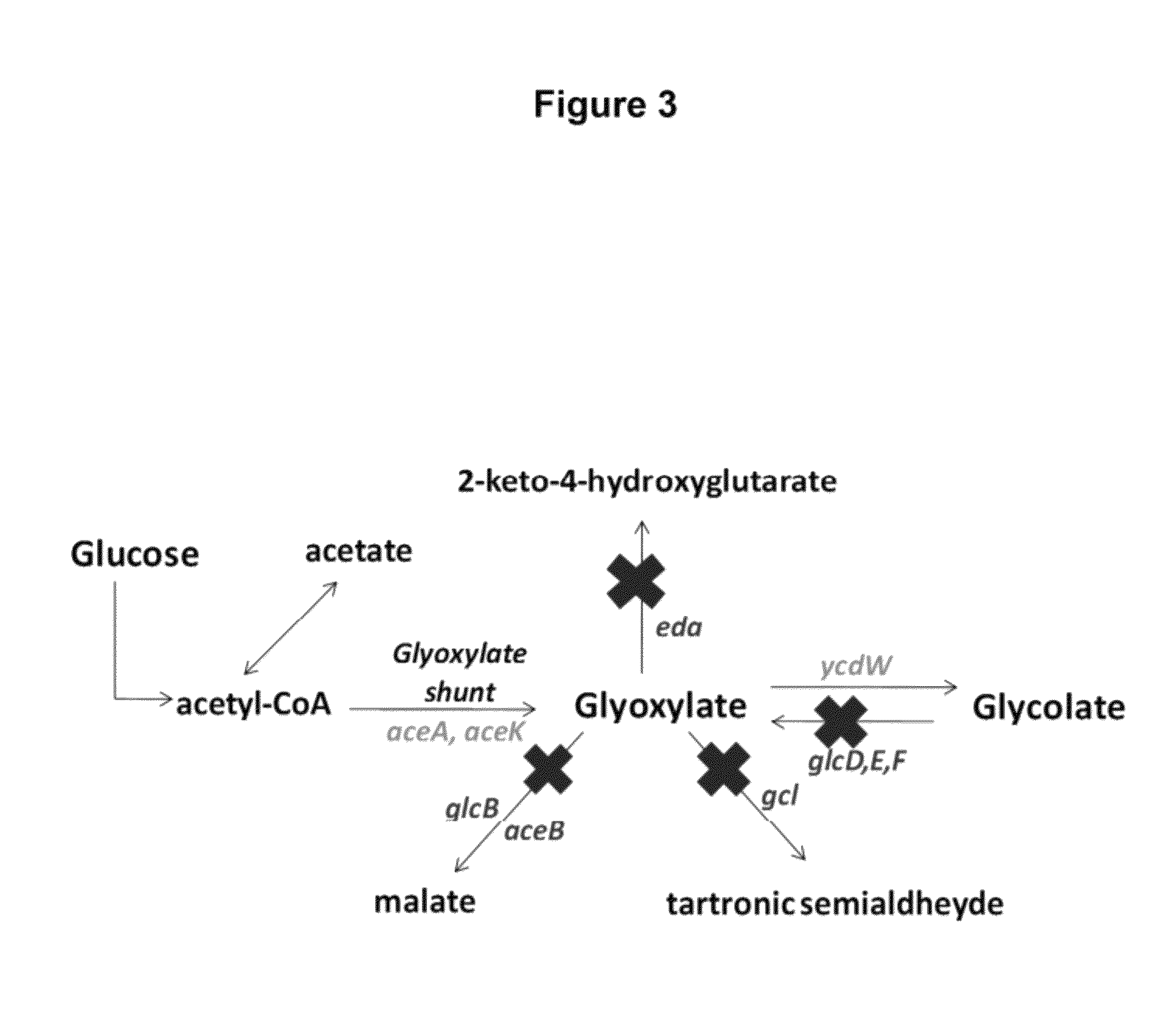Microbial production of 3,4-dihydroxybutyrate (3,4-DHBA), 2,3-dihydroxybutyrate (2,3-DHBA) and 3-hydroxybutyrolactone (3-HBL)
a technology of hydroxybutyrolactone and dhba, which is applied in the field of production of 3,4-dhba, 2,3-dhba and dhba, can solve the problems of high cost and low availability of dhba, low cost of 3-hbl, and inability to commercialize dhba, so as to reduce the availability of acetyl-coa, reduce the cost and availability of dhba
- Summary
- Abstract
- Description
- Claims
- Application Information
AI Technical Summary
Benefits of technology
Problems solved by technology
Method used
Image
Examples
example 1
Glycolate, DHBA and 3-HBL Synthesis in MG1655 (DE3)
[0119]Glycolate synthesis was first investigated in the E. coli K-12 strain MG1655 (DE3) transformed with pCOLADuet-ycdW-aceA-aceK in LB and minimal medium. pCOLADuet-ycdW-aceA-aceK is an IPTG inducible Duet vector which allows over-expression of the glycolate pathway enzymes YcdW, AceA and AceK. MG1655 (DE3) cells carrying pCOLADuet-ycdW-aceA-aceK, grown in minimal medium, synthesized up to 0.7 g / L of glycolate at the shake flask scale after 48 hours (as compared to a maximum of 0.25 g / L of glycolate observed in cells grown in LB) on induction with IPTG. Experiments with the same strain only expressing YcdW (off pCOLADuet-ycdW) or only YcdW and AceA (off pCOLAduet-ycdW-aceA) did not show any glycolate synthesis, indicating that co-expression of YcdW, AceA and AceK was beneficial for glycolate production.
[0120]However, the glycolate titers observed with MG1655 (De3) carrying pCOLAduet-ycdW-aceA-aceK were only observed transiently in...
example 2
Glycolate Synthesis in MG1655 (DE3) ΔiclR, Δgcl, ΔaceB and MG1655 (DE3) ΔiclR, Δgcl, ΔaceB, ΔglcB using pCOLADuet-ycdW-aceA-aceK
[0121]For the construction of a strain capable of sustained glycolate synthesis, the genes iclR, gcl, aceB and glcB were knocked out from MG1655 (DE3) to construct the strains MG1655 (DE3) ΔiclR, Δgcl, ΔaceB and MG1655 (DE3) ΔiclR, Δgcl, ΔaceB, ΔglcB. The iclR knockout is expected to relieve the transcriptional repression of the aceBAK operon to enhance endogenous AceA and AceK synthesis to complement the expression off pCOLADuet-ycdW-aceAa-aceK. The gcl, aceB and glcB knockouts eliminate some of the glyoxylate consumption pathways. Unlike the strains constructed in US 2009 / 0155867, the objective was not to construct a strain capable of maximum glycolate synthesis, but rather, to construct a strain capable of sustained glycolate synthesis that would be sufficient and optimized for DHBA synthesis. It should be noted, that since acetyl-CoA is a common interme...
example 3
Assessing Fitness of MG1655 (DE3) ΔiclR, Δgcl, ΔaceB Carrying pETDuet-bktB-phaB and pCDFDuet-pct-tesB with Respect to DHBA and 3-HBL Synthesis
[0126]To assess the fitness of strain MG1655 (DE3) ΔiclR, Δgcl, ΔaceB for DHBA and 3-HBL synthesis, MG1655 (DE3) ΔiclR, Δgcl, ΔaceB and MG1655 (DE3) carrying the DHBA / 3-HBL pathway plasmids (pETDuet-bktB-phaB and pCDFDuet-pct-tesB) were cultured in shake flasks in LB supplemented with 1% glucose. The objective, at least in part, was to assess if the knockouts introduced in the strain MG1655 (DE3) ΔiclR, Δgcl, ΔaceB had somehow impaired DHBA or 3-HBL synthesis. The results indicated that strains (MG1655 (DE3) ΔiclR, Δgcl, ΔaceB and MG1655 (DE3)) showed similar DHBA and 3-HBL titers at the shake flask scale, indicating that the knockouts had not in any way impaired the ability of MG1655 (DE3) ΔiclR, Δgcl, ΔaceB to synthesize DHBA and 3-HBL from glucose and glycolate.
PUM
| Property | Measurement | Unit |
|---|---|---|
| temperatures | aaaaa | aaaaa |
| concentration | aaaaa | aaaaa |
| concentration | aaaaa | aaaaa |
Abstract
Description
Claims
Application Information
 Login to View More
Login to View More - R&D
- Intellectual Property
- Life Sciences
- Materials
- Tech Scout
- Unparalleled Data Quality
- Higher Quality Content
- 60% Fewer Hallucinations
Browse by: Latest US Patents, China's latest patents, Technical Efficacy Thesaurus, Application Domain, Technology Topic, Popular Technical Reports.
© 2025 PatSnap. All rights reserved.Legal|Privacy policy|Modern Slavery Act Transparency Statement|Sitemap|About US| Contact US: help@patsnap.com



